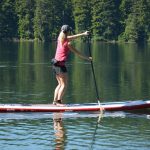If you’re wondering how to size your SUP paddle correctly, here are some things to keep in mind.
There is a lot of advice on the internet about the best way to pick a paddleboard in order to avoid injuries and poor posture. Some people say that the key to better paddleboarding is all about the materials, weight, and size, while others emphasize the importance of choosing the right length for your paddle.
Is this true? Yes.
We are going to discuss choosing a paddle for your board that is more than just the length.
If you want to learn more about sizing SUP paddles correctly, this guide will help you.
How Long Should a Paddle Board Paddle Be?
When my family and I first started paddle boarding, we just used whatever length paddle boards came with the cheap foam boards we bought to learn on. Luckily they were adjustable-length SUP paddles, so we could size them to any height we needed.
The trouble was we had no idea what size SUP paddle length each of us should use. So I did a ton of research and figured out the correct paddle board paddle height for each of us.
A paddle board paddle should generally be 8-10 inches taller than the paddler’s height. The ideal length is dependent on factors such as the paddler’s arm length, height, strength, the thickness of their paddle board, and what type of paddling they plan to do.
SUP paddle sizing can seem complicated, but it’s important to find the right size paddle for your board. I’m going to break it down and simplify the process so you can find the ideal paddle length for your needs.
Why Sizing Your Paddles is Important
Why do you need a paddle in the first place? Why do you need a paddle?
What’s stopping you from grabbing a paddle and hitting the waters?
The main reason for choosing a paddle that is the right length for you is that it will make your time in the water more enjoyable. A paddle that is too long will be cumbersome and will make your time in the water more difficult.
A too-short paddle will make you lean and force you into awkward positions, which will cause problems for your body over time.
It is important to have a paddle that is convenient and does not cause unnecessary pain. Let’s first understand the parts of a paddle before choosing one that meets all your expectations.
Paddle board paddle length is the most important thing to consider when starting your paddle boarding journey. Your board choice is less important than the right sized paddle.
It can be very frustrating to try and learn how to paddle with a board that is the wrong size. This can lead to bad paddling habits, or even make you not want to do the sport at all.
With the right sized paddle board paddle, you’ll:
- Maintain good balance on your board
- Be able to control and keep the correct paddling posture
- Paddle more efficiently and effectively
- Keep your knees slightly bent with little effort
- Conserve energy and be able to paddle longer and stronger
- More easily learn advanced paddle strokes and maneuvers
Parts of a SUP Paddle
as well as durable. An SUP paddle is a simple piece of equipment that is designed to be light and easy to use, as well as durable.
Your typical paddle has the following parts:
- T-Grip — This is the T-shaped part at the top of the blade. It has an ergonomic design that allows it to fit perfectly in your palm.
- Shaft — This is the long smooth cylindrical part of the paddle. It’s also where you’re supposed to place your other hand. Your shaft may also come with other parts such as a scale, which allows you to adjust the paddle’s length.
- Throat — This part joins the shaft and the blade.
- Blade — The flat and wide part of the paddle.
- Tip — The end of the blade.
There are two types of paddleboards — Inflatable and Hard. There are two types of people in this world — morning people and night people. There are two types of people in this world — those who are motivated by rewards and those who are motivated by punishment.
If you are planning on sharing your adjustable paddles with others, it is beneficial to get ones with a dual lock pin and clasp.
Fixed paddles can’t be adjusted.
By understanding the different parts of a paddle, you will be able to better understand hand placement concepts and how to size your paddle.
Adjustable vs Fixed Length SUP Paddles
If you are new to the sport of stand-up paddleboarding, and especially if you are working with a limited budget, I suggest you purchase an adjustable SUP paddle. There are a few reasons why this is my recommendation.
- Many entry-level budget boards come with an adjustable paddle.
- If you’re sharing boards and paddles with family or friends, you can change the SUP paddle’s length to suit each paddler.
- Until you paddle a while, you won’t know the exact SUP paddle length that’s right for you.
- An adjustable SUP paddle will let you try out several lengths/heights to see which one feels the best when you paddle.
An adjustable SUP paddle will let you choose your ideal paddle length before you spend money on a fixed-length paddle.
While adjustable paddles may not perform as well as more expensive options, they are more budget-friendly. If you make a mistake when choosing the length of your SUP paddle, you can adjust it, rather than having to buy a new one.
Don’t worry, you’ll eventually want to upgrade to a nicer paddle board paddle once you get into the sport. That’s part of the fun, learning and then wanting better equipment.
Let’s make sure you choose the right length for your SUP paddle. It will make a big difference.
Factors to Consider
It is important to choose a SUP paddle that is the right height for you and not just one that is slightly taller than you.
Here are some of the factors to consider before you pick the length of your paddle:
Individual User
Many of the considerations you make when picking a paddle have to with your personal preferences.
They include:
- The length of your shoulders. If your shoulders are broader than average, it helps to pick a longer paddle.
- Paddling style — If your technique involves a more upright stance, opt for longer paddles. If you paddle while hunched over, you might get more joy from picking a shorter paddle.
- General fitness — people with shoulder or elbow issues will get more benefit from a shorter paddle.
Purpose of the SUP Paddle
A SUP paddle can be used for many reasons. These include:
Paddle boarding and surfing are great activities that will help you improve your ability to move around on the board.
You should use a longer paddle by one or two inches of your normal height for racing, touring and activities that involve a lot of tracking.
Sizing Methods
The parts of a paddle and how to determine its length by considering all the important points mentioned above have been learned by you.
But how do you pick the right length?
What is the rule of thumb when it comes to sizing a paddle?
The general rule of thumb for paddle height is to get one that is a few inches taller than you.
Is this correct?
Although many people will say that there is a perfect size for a paddle, it actually varies for each individual. This is because it is based on personal factors such as height, weight, and stance.
The size of your paddle should be based on what kind of racing or paddling you plan to do. If you want more powerful strokes, you should get a paddle that is slightly longer. If you are paddleboarding over waves, you should get a paddle that is shorter so it is easier to move.
Keep in mind that what works for someone else might not work for you. Be sure to try all the different techniques outlined in this guide so you can determine which one is the most convenient and practical for you.
-To start, hold the paddle upright in front of you and position it so the blade is in the water.
-Then, extend your arms out to the side and measure from the tip of the blade to the center of your chest.
-This number is the ideal paddle length for flatwater paddling.
Here are a couple additional methods for finding the right SUP paddle size for you:
-Start by holding the paddle upright in front of you, with the blade in the water.
-Then, reach your arms out to the side and measure from the tip of the blade to the center of your chest.
-This measurement is the ideal paddle length for flatwater paddling.
Use the Paddle Height Chart
Wait until the paddle is in the water to set the right height. If you set it too high, the wind will catch it and you’ll have to paddle harder. Calibrate your paddle so that it is the right height by using a paddle that is adjustable and setting the height in the water.
This will save you from having to paddle too hard against the wind.
The method is also good for making adjustments. All you have to do is go through the different heights and find what feels most natural.
Laird Hamilton Method
This method was prescribed by Laird Hamilton, one of the pioneers of SUP sports. He devised a simple method to size your paddle in a matter of seconds. All you need is a tape measure and your height.
To measure your paddle, stand up straight with your arms at your sides. Have someone else measure from the ground to the space between your wrist and your elbow. That’s your ideal paddle length!
He says to hold the paddle upright so that it’s even with how tall you are. Then to set the paddle 3-4 inches above your head. After that you can change the height of the paddle depending on what you need.
Hands Up Method
Place the paddle so that it is level with your body and raise one hand as if you are going to do a pull-up. The end of the paddle should be touching the ground. Your hand should be outstretched to the point where the T-grip or end of the paddle fits comfortably in your palm.
The all-around method is also known as the all-around method. It is ideal for understanding how the paddle will feel when you hit the water. It is also helpful for people who want to improve their paddling technique.
The Shaka Method
The Shaka method is best for those who want to surf – it provides great maneuverability.
To do the Shaka, hold the paddle parallel to your body, with the tip touching the ground. Make a fist, sticking your thumb and pink out, and place the thumb on top of your head, with the pinky pointing out.
Now adjust the height of the paddle so that the top aligns with the tip of your pinky finger.
Touring Method
The grip can be positioned anywhere on the paddle shaft This paddle grip positioning method is also called the Eye-level method. To do this, you need to turn the paddle upside down so the blade is pointing upwards.
Then, you need to adjust the length of the paddle until your eyes are in line with the throat of your paddle. You can position the grip anywhere on the paddle shaft.
The paddle used in the hands-up technique will be shorter than the one used in the touring and racing technique. However, the shorter paddle will be great for beginners.
Quick and Dirty SUP Paddle Sizing Method
There are a couple of variations to this method, but they all involve the following steps:
- Stand your paddle straight up and down right in front of your dominant arm (If you’re right-handed in front of your right arm).
- Make sure the blade’s power face is toward you—blade bent forward.
- Reach your hand straight up in the air like you were trying to touch as high as you could while flat-footed.
- Wrap your fingers over the SUP paddle’s rounded handle or “T” grip.
- Depending on who you listen to, your fingers should comfortably wrap over the handle with the top of the paddle right at the joint between your hand and where your fingers start. Or…
- Another popular method is that the top of the “T” or rounded handle will be right at your wrist joint.
The best way to find the correct length for your paddle board is to try different lengths and see which one works best for you.
Eyes and Throat Paddle Sizing Method
Popular methods to make your paddle last longer is to either stand it up in front of your face, or lay it flat on the ground.
The “throat” is the part of the paddle where the blade meets the shaft. The “Eyes and Throat” method is where you paddle with the throat of the paddle at eye level.
This position puts the SUP paddle blade 8-12 inches over your head. Here are some guidelines for choosing the right paddle length.



